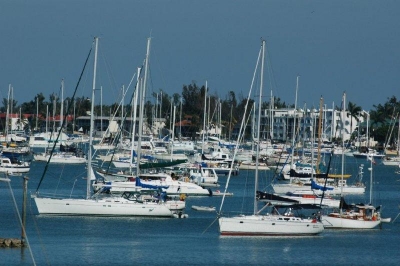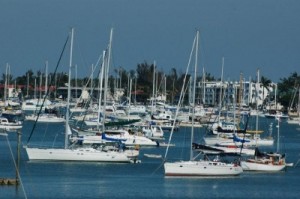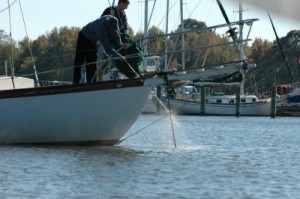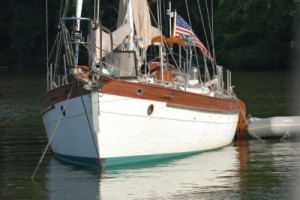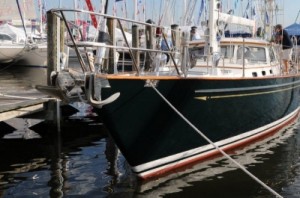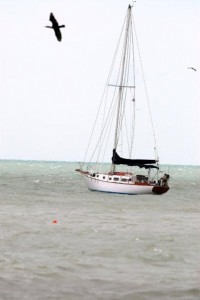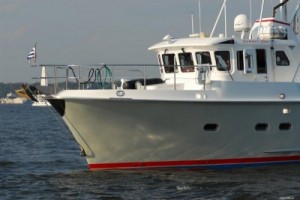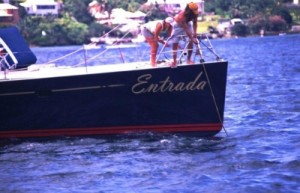Anchors Aweigh
by Ralph Naranjo
All photos copyright Ralph Naranjo
Different vessels and different cruising destinations often call for different anchors. Is there a perfect anchor?
Large anchors and heavy-duty ground tackle handling gear are a cruiser’s tools of the trade. The gear comes in a mind-boggling array of shapes and styles, but no one anchor pattern fits all applications. To further complicate matters, it’s not always easy to sort promotional spin from sound engineering practice. Many anchor manufacturers lay claim to the world’s best answer to staying put, but none back it up with a “never drag” warranty. The big challenge lies in sorting through all the bewildering claims and determining what will work best for you and your boat.
The physics behind successful anchoring is pretty simple. Holding power is the result of two relevant factors—an anchor’s ability to grab hold of the bottom and, to a lesser extent, the frictional resistance to dragging related to the weight of the anchor and chain. Mushroom shaped mooring anchors and the heavy, low fluke-to-weight ratio Navy type anchors are more dependent upon deadweight holding power rather than bottom grabbing ability. High fluke-area-to-weight anchors approach immobility from the opposite direction. They are designed to dig themselves into a penetrable bottom and use their increased surface area to hold tight to the substrate. The Danforth is a classic example of such a design. In between these opposing benchmarks reside the plows, claws, kedges and an array of newcomers like the Rocna, Manson, Spade and others.
All chain rode makes for a durable and strong connection to the bottom.
Early alternatives
The kedge, known also as a fisherman anchor, is symbolic of tall ships and the era of sail. These anchors evolved from crude castings with wooden stocks into much stronger, drop-hammer-forged steel designs that were eventually dipped in hot baths of molten zinc to lessen corrosion. In the days when ships sported lengthy bowsprits, these anchors could be easily handled and secured to hefty timbers called catheads.
When deployed, only one fluke engages the bottom; the other points upward, contributing weight but nothing else to the holding power of the anchor, while increasing the potential for the anchor rode to foul the anchor. Among professional mariners in the last days of sail, the kedge anchor was nicknamed the “pick” for its ability to penetrate hard-scrabble bottoms, and it still leads the list of anchors capable of grabbing a hard or rocky bottom. However, heavy weight and handling difficulties have lessened its popularity. One of the last remaining holdouts is the innovative Luke three-piece kedge that features easy disassembly for stowage, rugged construction, and Herreshoff-type flukes for holding power. A tried and proven storm anchor, it continues to be favored by those voyaging far afield and facing the possibility of riding out a serious storm on their own ground tackle.
In the early 1800s, the U.S. Navy developed a stockless anchor pattern that could grip the seabed with both flukes simultaneously and would also self-stow when hauled into a hawsepipe built into a vessel’s hull, thus eliminating the awkward and occasionally hazardous cathead-securing procedures used aboard early sailing ships. Today, this anchor design is seeing a renaissance in the megayacht industry, and custom-fabricated stainless steel behemoths can be seen tucked into the hawsepipes of sail and motor yachts in excess of 100 feet long.
Confidence in your ground tackle is of paramount importance. The right equipment for the bottom conditions is the key.
Legions of lightweights
What at first sounds like anchoring heresy is actually a good example of effective engineering, proof that better anchors, like better mouse traps, can still be developed. A light anchor derives its holding power from fluke area, and the anchor must be designed so that its fluke or flukes will bury in and engage with the seabed in response to a strain on the ground tackle.
The prototypical light anchor is R.S. Danforth’s lightweight pattern, which gave the landing barges of WWII a better chance of getting off the beach once the troops had been deployed. His landmark reimagining of anchor design utilized the navy anchor concept of engaging both flukes simultaneously, but he went further, attaching deeply penetrating flukes to a stock that is mounted at the crown rather than at the upper end of the anchor. Comparing a traditional kedge to a Danforth is like comparing a pickup truck to a motorcycle: Both might be able to cruise at 60 mph on the highway, but the motorcycle does it with a lot less steel.
The geometry of the Danforth is its main advantage as well as its Achilles’ heel. Trapping the tip of one of the long, thin, flat flukes in a rocky fissure or coral-reef recess can result in bending or tearing off the fluke, rendering the anchor useless. The huge ground-tackle strain generated by even a small swell can be taken in stride by a Danforth that is well set in a sand or mud bottom, but a Danforth that is holding by its fluke tips stands a very real chance of being damaged in such conditions. A crew should check the seabed type on a large-scale chart before dropping the hook, and if cruising in tropical waters, a swim with a dive mask can answer any lingering questions.
Over the years, the Danforth pattern has been marketed as a standard “S” anchor and in an “H” series designed with higher tensile strength and a “deep-set” pattern. The venerable “H” series is made from stronger steel and is both more ruggedly built and capable of enduring higher loads. The stock is made from drop forged steel and the material’s increased expense pays off in the long run. Danforth copies can be found throughout the world in every marine marketplace. More inexpensive models tend also to be less well constructed, and their slight design modifications, which are meant to improve the pattern, cut costs, or both, often turn out to be steps backward rather than ahead.
The latest iteration of this flat pattern design is the Fortress anchor, which is fabricated from an aluminum-magnesium alloy with no welded seams. The Fortress has shown great holding power in sandy and mud bottoms, and its large ratio of fluke area to weight makes it a good choice for mariners who stow their anchors in an anchor well or stern lazarette rather than on a bow roller. A less expensive model, called the Guardian, is built from the same alloy but in a lighter extrusion; it is not anodized and does not offer all the options found in the Fortress.
An aluminum alloy anchor might be pound-for-pound stronger than steel, but this statistic can be misleading. Steel is a ductile, high-yield material; yield being the measure of a material’s ability to cope with loads high enough to cause permanent deformation. The higher a material’s yield, the more distortion it will endure prior to ultimate failure—i.e., the wider the range of loads over which it will bend but not break. Steel has a much higher yield than aluminum, which is one reason why steel continues to be popular for anchors. Many boatowners reason that a bent shank is better than a broken one. The fact that steel has a lower strength-to-weight ratio than aluminum isn’t necessarily bad, since there’s much to be said for adding more material—increasing both the strength and weight of an anchor.
This cruiser has the right idea. With both a plow and a Bruce-style anchor (and a storm anchor in the lazarette), the boat is ready to take on most anchoring scenarios.
Plowing the bottom
The plow anchor caught on in the UK just after WWII, and while the Danforth was grabbing market share in the U.S., the Brits showed a preference for a more heavy-duty approach to ground tackle. Their preference for all-chain rode and a heavier anchor capable of being stowed in a bow roller was influenced by the wider diversity of bottom conditions and the more volatile weather conditions that characterize the British Isles.
The drop-forged steel shank of a CQR (for the word “secure”) resists bending regardless of what the tide or passage of a cold front does to the angle of pull. The anchor is at home in sand, mud, gravel, rock, or coral bottoms, and it partners well with an all-chain rode. These rugged anchors rely upon a combination of weight, fluke shape, and size for their holding ability. Though their holding power falls in the middle of the pack when tested in ideal conditions, they tend to perform well in a variety of challenging conditions.
A farmer’s plow is designed to penetrate the earth and present a certain amount of resistance, but not too much. As a furrow-digging implement, its mission is to till the soil, not anchor the tractor. But tilling the seabed is not a mariner’s idea of how an anchor should behave, and despite its plowshare shape, the CQR’s steep angle of attack compels it to dig in rather than drag along the bottom. In ideal sandy-bottom conditions, a good Danforth will generate more holding power per pound than a CQR plow, but the plow may perform better when the holding is less than ideal.
Lots of scope and a gentle rode angle are your allies when anchoring, particualrly in exposed positions. It’s days like this when an oversized, and correctly chosen anchor and ground tackle pay for themselves.
The delta and other plow derivatives
Like all good inventions, the CQR plow evoked mimicry in the marine marketplace. One of the first competitors was Woolsey, whose Plowright anchor represented a slight variation on the original plow. A close look at the Woolsey and other plow copies reveals subtle changes, some aimed at improving holding power and others aimed at making the anchor cheaper to build. For example, the shank of the Woolsey version of the plow is made from mild-steel flat stock with welded ears or tabs to allow the flukes to pivot. The flat shank makes the anchor more susceptible to bending when heavy side loads are imposed.
The Delta plow anchor is a cut-out and welded-up plow-shaped anchor with good holding power, but if you were to jam a CQR and a Delta side by side in a rocky fissure and put equal side loads on each shank, the drop-forged CQR would stand a better chance of retaining a straight stock.
Claws, Scoops, and Spoons
The Bruce pattern anchor arrived on the waterfront in the mid-1970s and earned quick acceptance for three good reasons. The first and foremost of these is its ability to dig in and provide respectable holding power in a variety of substrates. The second is its rugged, no-weld, carefully cast construction. Though not as structurally reliable as drop forging, the design of the shank and claw like arms confer ample strength and an impressive ability to escape damage when unanticipated loads are encountered. Finally, like a plow anchor, the Bruce happily nests in a bow roller, making deployment and recovery a much more manageable experience. The two extra outboard fluke tips love to grab spinnaker sheets and guys, but non-racers and power cruisers find little to complain about.
Today, copies of the original anchor have sprung up all over the world, but most are less-carefully cast facsimiles that do not perform as well. A good reason for choosing a tried and proven anchor from a reputable manufacturer is that its design has been fine-tuned and glitches and flaws corrected over time. Conversely, joining the first wave of ownership of a new design or a new builder’s effort can be a gamble, and unknown odds are not a desirable attribute when it comes to anchoring.
Take for example the shiny, stainless steel Bruce facsimiles seen gleaming in bow rollers in marinas and boat shows around the world. These anchors are more nearly objets d’art than purposeful tools, and are truly at their best undeployed, gleaming at the stem like a prized piece of sculpture. Stainless steel is a great metal for certain hardware needs, but an anchor is not one of them. For cosmetic reasons, unsightly welds are usually ground smooth and the metal polished to gleaning reflectivity, neither of which assists the anchor in its primary role. In fact, the welds are usually in key high-load junctions and are almost never X-rayed to establish quality. These welded stainless steel anchors will work-harden over time and become more and more susceptible to micro cracking and crevice corrosion.
Other Single-Fluke Anchors
A new generation of single-fluke anchors has been spawned in recent years, each promising to be better than its competitor. Many have a roll bar-like addition meant to function like a stock, encouraging the anchor to jab the pointed end of its fluke into the bottom. Most provide stellar performance in mud and sand bottoms due to their sizable spoon- or shovel-shaped flukes with chisel-like points for bottom penetration. The list includes:
• Spade–This French product can be disassembled and is available in galvanized steel, aluminum, or stainless steel.
• Rocna—This well-crafted, roll-bar-fitted, New Zealand-made anchor has a single large fluke with a sharp, bottom-piercing tip. Currently manufactured in China and some questions regarding metallurgy have arisen.
• Manson Supreme–Another New Zealand-made roll-bar anchor, this one offers good sandy-bottom holding power and carefully executed welds.
• Bugel—This is one of the earliest roll-bar, pointed- tip, single-fluke designs.
• SARCA–This Australian rendition of the roll-bar single-fluke anchor is touted as being optimized for sand and rock. It incorporates numerous slots intended to allow the anchor to break free during retrieval.
• Bulwagga–This triple-fluked, equilaterally shaped anchor is optimized for setting regardless of the orientation with which it lands on the bottom. Rock entrapment and fluke vulnerability remain issues.
This trawler’s oversized plow anchor will serve it well in a variety of conditions. Larger vessels with more windage require more substantial ground tackle. When in doubt, err conservatively, go larger.
Holding power versus strength
Most anchor tests are conducted on sand or thick mud bottoms—the best-case scenario. Deep fluke penetration inflates holding power measurements, and the steady, in-line, tugboat-like pull that is applied to an anchor rode in such tests is nothing like what really goes on in gale- or storm-force conditions. In extreme weather, especially in tropical storm conditions, gusts associated with spiral bands can cause a vessel to pitch and yaw at anchor, creating varied load intensities and directions of pull on the ground tackle.
An anchor optimized for holding power in sand and mud is well and good, but obstacles in the path of an anchor can range from a small stone capable of rendering a Danforth-pattern anchor useless to a glacial-erratic chunk of granite that can point-load the tip of a fluke and bend or break it under the load of a surging vessel. If all that’s keeping your boat off a hungry lee shore is the tip of the fluke, you want that fluke to be a rugged, well-reinforced piece of metal capable of sustaining the load. The same goes for an anchor wedged in a granite ledge or coral reef while a vessel pulls sideways against its shank.
Many anchors include a welded joint at the fluke-to-shank junction—which is a nearly 90-degree joint in a welded fabrication–and this needs to be the best weld possible. Other builders slot the shank into the fluke and pin it in place, creating a significant stress riser that could lead to potential failure. A drop-forged structure eliminates these inherently weak points, but anchor manufacturers these days lean toward less expensive welded and cast alternatives.
Cyclical loading can cause metal fatigue, which can lead eventually to shank bending and deformation or even breakage. Only a long-term, long-distance cruiser is likely to subject his ground tackle to the degree of day-in, day-out loading that would cause these effects over the short-term. Still, the effects of cyclical loading are cumulative, and over time—perhaps abetted by corrosion and by microcracks in welds—failure could result.
An anchor shank acts like a tiller, steering the flukes into alignment with the pull of the ground tackle. The length of the shank versus the holding power of the flukes determines how much energy is required to turn the anchor. A short shank is less likely to bend when the anchor becomes wedged in a rocky or coral bottom, but it is also less likely to steer the flukes into a new alignment with the passage of a cold front, and force exerted by the rode on a misaligned anchor can yank the anchor backwards out of the substrate, completely upsetting its hold.
With such considerations in mind, rank ruggedness of construction higher than per-pound holding power. You can gain additional holding power by selecting an anchor one size larger than the tables say you need, but weak construction is independent of anchor weight, and a critical failure of the anchor can be much more hazardous than a slow drag, which can often be halted with additional scope.
Long term cruisers often spend much more time at anchor than they do underway, so the chance of being weather tested on your own ground tackle changes from a remote possibility to a distinct likelihood. In short, it means that the serious cruiser needs quality ground tackle and anchor handling gear, preferably it’s one size larger than what the “every day” manufacturer’s recommendations call for, and most important of all, the crew understands and has the skills to make the most of the ground tackle they have on board
Choose your anchors wisely and make sure your rode and bow roller, chocks and cleats are up to the task. Nothing is worse than dragging in the middle of a stormy night, or worrying that you might.
For more information on the services provided by Steve D’Antonio Marine Consulting, Inc. please e mail Steve at info@stevedmarineconsulting.com
or call 804-776-0981

